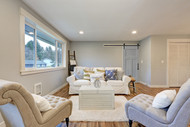A Guide to Interior Design Styles: Craftsman
Feb 18th 2019
The Craftsman interior design style came about in reaction to the British Industrial Revolution of the late 19th century. During the revolution, mass-produced construction was popular. Many rejected that and instead embraced the more contrary Arts and Crafts Movement which favored handcrafted products.
In America at the turn of the century, Gustav Stickley pioneered the Craftsman movement. He was the founder and editor of The Craftsman magazine and sold blueprints for homes designed in the Arts and Crafts style. He was so influential that initially the term “Craftsman” was only used to describe homes built with one of his plans. Today, Craftsman homes have many common features and stay true to Stickley’s vision with unique and functional details.
What makes a Craftsman home special? These homes are known for their individuality and functionality. While designs also born of the same era, such as Victorian, led with aesthetics, Craftsman leads with functionality (without sacrificing beauty). Some key interior features of a Craftsman home include eye-catching fireplaces, window seats, nooks, built-in storage, double hanging windows, and natural materials throughout especially wood and stone. (Common exterior features include covered front porches, entry pillars, exposed rafters, and protruding dormers.)
Without moving or renovating, how can you create a Craftsman look in your home? Follow these guidelines and you will see a wonderful transformation inside your home.
Go Vintage
Look for wood pieces and collectibles at your local vintage stores, thrift stores, flea markets, and estate sales. If you are patient, you may find some real gems. Search for the straight lines of Stickley, Shaker, and Frank Lloyd Wright-influenced designs. Also, scour for anything from antique maps and aquariums to dining tables and book cabinets. There are a lot of great finds out there. Couple the more solid pieces with lighter painted furniture.
Lighting
Changing your lighting can make a big difference in your room’s ambiance. Craftsman lighting is characterized by its simplicity. Most lighting designs are metals such as copper or iron. Colored opaque glass or milk glass is typical of the Craftsman period. Focus on utilitarian designs and you will transform your home with lamps, sconces, and lighting fixtures.
Color
Craftsman-style homes are dominated by earth-tones. Surround yourself with earth browns, shades of greens, ocean blues, sunset oranges, and sunlight yellows. Avoid heavy hues of these colors and include a neutral color with undertones of a blue or green to sync your color scheme.
Flooring
Craftsman-style homes have natural fiber floors like wood, stone, cork or bamboo. Natural highly-polished floors are a decorative earth-tone element in themselves. If you have carpet, don’t feel like you must redo your floors, although that is an option. You may add hooked area rugs, both on carpet or bare floors to evoke memories of the past. On bare floors, monochromatic rugs keep your room simply elegant. Many Craftsman entryways have tiled mosaics.
Accessories
It’s time to head back to the flea market or thrift store for accessories. Anything from a wooden porch swing to terra cotta pots will brighten up your Craftsman home. Iron and metal are common for items like switch plates and heating grates. Another fun way to do accessories is with a nod to family. Display old photos in rich-toned wood frames. Place keepsakes in shadow boxes. Or, perhaps you have family heirlooms to display such as an old ship’s manifest from when your great-grandfather came to America. These are all wonderful parts of our heritage and will shine in a Craftsman home.
Barn Door
Another way to honor the Craftsman theme is to install a Craftsman-style barn door in your home. Barn doors come in a wide variety of styles and are a beautiful focal point in any room. Have questions about which barn door is right for you? Contact us, we’re here to help.
